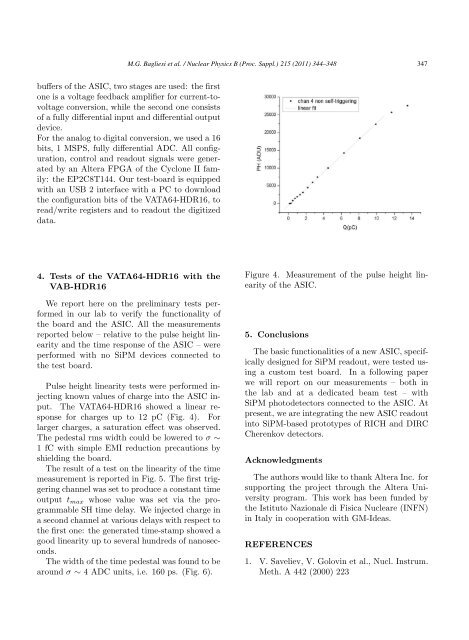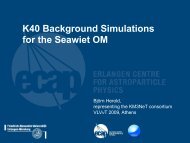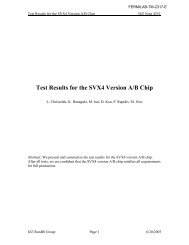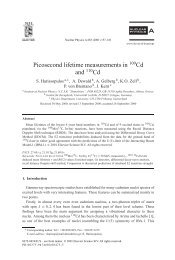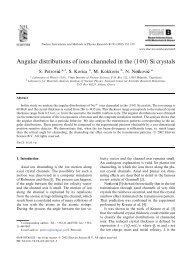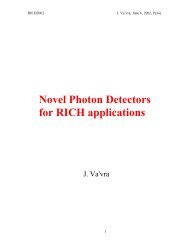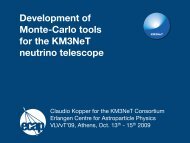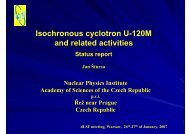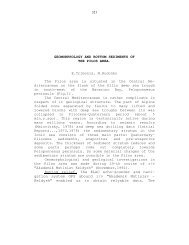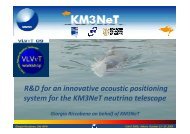A custom front-end ASIC for the readout and timing of 64 SiPM ...
A custom front-end ASIC for the readout and timing of 64 SiPM ...
A custom front-end ASIC for the readout and timing of 64 SiPM ...
Create successful ePaper yourself
Turn your PDF publications into a flip-book with our unique Google optimized e-Paper software.
M.G. Bagliesi et al. / Nuclear Physics B (Proc. Suppl.) 215 (2011) 344–348 347<br />
buffers <strong>of</strong> <strong>the</strong> <strong>ASIC</strong>, two stages are used: <strong>the</strong> first<br />
one is a voltage feedback amplifier <strong>for</strong> current-tovoltage<br />
conversion, while <strong>the</strong> second one consists<br />
<strong>of</strong> a fully differential input <strong>and</strong> differential output<br />
device.<br />
For <strong>the</strong> analog to digital conversion, we used a 16<br />
bits, 1 MSPS, fully differential ADC. All configuration,<br />
control <strong>and</strong> <strong>readout</strong> signals were generated<br />
by an Altera FPGA <strong>of</strong> <strong>the</strong> Cyclone II family:<br />
<strong>the</strong> EP2C8T144. Our test-board is equipped<br />
with an USB 2 interface with a PC to download<br />
<strong>the</strong> configuration bits <strong>of</strong> <strong>the</strong> VATA<strong>64</strong>-HDR16, to<br />
read/write registers <strong>and</strong> to <strong>readout</strong> <strong>the</strong> digitized<br />
data.<br />
4. Tests <strong>of</strong> <strong>the</strong> VATA<strong>64</strong>-HDR16 with <strong>the</strong><br />
VAB-HDR16<br />
We report here on <strong>the</strong> preliminary tests per<strong>for</strong>med<br />
in our lab to verify <strong>the</strong> functionality <strong>of</strong><br />
<strong>the</strong> board <strong>and</strong> <strong>the</strong> <strong>ASIC</strong>. All <strong>the</strong> measurements<br />
reported below – relative to <strong>the</strong> pulse height linearity<br />
<strong>and</strong> <strong>the</strong> time response <strong>of</strong> <strong>the</strong> <strong>ASIC</strong> – were<br />
per<strong>for</strong>med with no <strong>SiPM</strong> devices connected to<br />
<strong>the</strong> test board.<br />
Pulse height linearity tests were per<strong>for</strong>med injecting<br />
known values <strong>of</strong> charge into <strong>the</strong> <strong>ASIC</strong> input.<br />
The VATA<strong>64</strong>-HDR16 showed a linear response<br />
<strong>for</strong> charges up to 12 pC (Fig. 4). For<br />
larger charges, a saturation effect was observed.<br />
The pedestal rms width could be lowered to σ ∼<br />
1 fC with simple EMI reduction precautions by<br />
shielding <strong>the</strong> board.<br />
The result <strong>of</strong> a test on <strong>the</strong> linearity <strong>of</strong> <strong>the</strong> time<br />
measurement is reported in Fig. 5. The first triggering<br />
channel was set to produce a constant time<br />
output t max whose value was set via <strong>the</strong> programmable<br />
SH time delay. We injected charge in<br />
a second channel at various delays with respect to<br />
<strong>the</strong> first one: <strong>the</strong> generated time-stamp showed a<br />
good linearity up to several hundreds <strong>of</strong> nanoseconds.<br />
The width <strong>of</strong> <strong>the</strong> time pedestal was found to be<br />
around σ ∼ 4 ADC units, i.e. 160 ps. (Fig. 6).<br />
Figure 4. Measurement <strong>of</strong> <strong>the</strong> pulse height linearity<br />
<strong>of</strong> <strong>the</strong> <strong>ASIC</strong>.<br />
5. Conclusions<br />
The basic functionalities <strong>of</strong> a new <strong>ASIC</strong>, specifically<br />
designed <strong>for</strong> <strong>SiPM</strong> <strong>readout</strong>, were tested using<br />
a <strong>custom</strong> test board. In a following paper<br />
we will report on our measurements – both in<br />
<strong>the</strong> lab <strong>and</strong> at a dedicated beam test – with<br />
<strong>SiPM</strong> photodetectors connected to <strong>the</strong> <strong>ASIC</strong>. At<br />
present, we are integrating <strong>the</strong> new <strong>ASIC</strong> <strong>readout</strong><br />
into <strong>SiPM</strong>-based prototypes <strong>of</strong> RICH <strong>and</strong> DIRC<br />
Cherenkov detectors.<br />
Acknowledgments<br />
The authors would like to thank Altera Inc. <strong>for</strong><br />
supporting <strong>the</strong> project through <strong>the</strong> Altera University<br />
program. This work has been funded by<br />
<strong>the</strong> Istituto Nazionale di Fisica Nucleare (INFN)<br />
in Italy in cooperation with GM-Ideas.<br />
REFERENCES<br />
1. V. Saveliev, V. Golovin et al., Nucl. Instrum.<br />
Meth. A 442 (2000) 223


